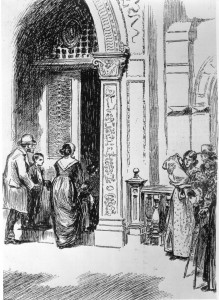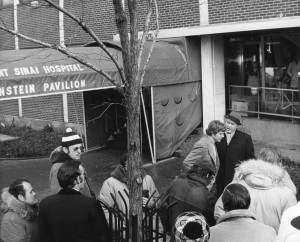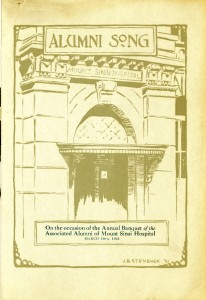Mar 8, 2016

The entry to the Mount Sinai dispensary building where Dr. Welt served as chief of a pediatric clinic. This building on East 67th Street opened in 1890. In 1904 Dr. Welt moved with the clinic to the corner of Madison Avenue and 100th Street.
In honor of International Women’s Day, celebrated on March 8th, the Mount Sinai Archives wants to highlight a woman who is not remembered today, but who made a big impact on The Mount Sinai Hospital, Sara Welt Kakels, MD. Dr. Welt (1860-1943) was born in Czernowitz, Bukovina. She was one of four sisters, three of whom became physicians and the fourth a chemist. Sara Welt received her medical degree from the University of Zurich in 1885 and moved to New York City shortly thereafter to be with her sister, Dr. Rosa Welt Strauss, an ophthalmologist who also taught at The Mount Sinai Hospital School of Nursing.
In 1887, Dr. Welt was appointed to replace Mary Putnam Jacobi as one of the four heads of the Pediatrics clinics at the Hospital. She remained in charge of the clinic while she built a private practice in the community. In 1922 Sara Welt was the first woman to be appointed to the rank of Adjunct Pediatrician at Mount Sinai. She stepped down from active service in 1926 but remained closely affiliated with the Pediatrics Department until her death in 1943, at which time she bequeathed nearly $1,000,000 to Mount Sinai to establish the Sara Welt Memorial Fund, which established the Welt Fellowship program for young physicians who needed financial help, and also provided support of the Pediatric Clinic.
Dr. Welt married Moses S. Kakels, MD, a surgeon at the Mount Sinai clinics but primarily affiliated with Lebanon Hospital. Dr. Welt was very involved in teaching. She held appointments at the Women’s Medical College of the New York Infirmary, where she was an Instructor in the Practice of Medicine. She also lectured at The Mount Sinai Training School for Nurses on Anatomy and Physiology. She was an active member of The New York Academy of Medicine, as well as the New York Pathological Society. She had a pioneering interest in pediatric gynecology, and published over 20 articles on this and other topics.
When she died in 1943, the American Jewish Yearbook noted her final benevolence:
WELT-KAKELS, SARA (MRS. MOSES S. KAKELS), pediatrician Mt. Sinai Hosp., New York, N. Y., (d. Dec. 26, 1943), bequeathed to N. Y. Academy of Medicine $100,000 for aid of sick and needy physicians, $10,000 for lectureship by a pediatrician, and $20,000 for books and literature for library; $20,000 to Lebanon Hosp. for fellowship in surgery in honor of her husband; $10,000 to Hampton (Va.) Normal Agricultural Institute for establishment of four scholarships; and residuary estate, valued at $874,222, to Mt. Sinai Hosp., to set up “The Sara Welt Memorial Fund” ” and establish six traveling fellowships; reptd Feb. 6, 1946.
Sara Welt Fellows continued at The Mount Sinai Hospital for decades. Her support of these young doctors allowed her to touch the lives of thousands of patients.
Feb 24, 2016
A recent blog post from the History of Medicine Division of the National Library of Medicine (NLM) celebrates the wonderful resource in the history of medicine that is PubMed Central. Best known as a source of current, full-text biomedical articles, PubMed Central also includes the contents of medical journals dating back to 1809. NLM notes that there are now over 3.8 million total items available in PubMed Central.

A word cloud created by the National Library of Medicine showing the frequency of medical subject terms used to describe articles in PubMed Central.
The earliest article that mentions Mount Sinai dates to 1871 and the earliest article found that was written by a Mount Sinai physician was “On the Surgical Dissemination of Cancer” by Arpad G. Gerster, then Director of the Department of Surgery. Gerster was the first to suggest that cancer might be spread by surgical procedure.
Read the NLM blog post and then play around in PubMed Central. You are sure to find something of interest there.
Feb 4, 2016
In honor of Valentine’s Day, the Mount Sinai Archives looks at Mount Sinai’s ties to one of the most romantic movies of all time, “Love Story.” Yes, that 1970 classic tear-jerker that made the phrase, “Love means never having to say you’re sorry” a cultural phenomenon. It was a meme before memes were a thing.

Filming “Love Story” outside of the Klingenstein Pavilion on 5th Avenue, c1969.
So, what role did Mount Sinai play in the movie? As you know (come on, the movie is 45 years old, there are no spoiler alerts), Jenny, played by Ali McGraw, meets and marries Oliver (Ryan O’Neal) while at Harvard and then falls ill and spends her final days – where else? – at The Mount Sinai Hospital Klingenstein Pavilion. There is a tense and touching scene at the end of the movie, after Oliver exits KP out onto 5th Avenue, between Ryan O’Neal and Ray Milland, who played his father.
Think this is old news? Just a few days ago, the Huffington Post ran a piece about how the two co-stars, McGraw and O’Neal, had put in an appearance at Harvard. Apparently, “Love Story” also means never having to say good-bye.
Jan 27, 2016
The Mount Sinai Archives has mounted its latest quarterly exhibit in the Annenberg elevator lobby. This season’s exhibit covers the history of the former Continuum Health Partners hospitals that are now part of the Mount Sinai Health System: Beth Israel Medical Center (now Mount Sinai Beth Israel), St. Luke’s Hospital (now Mount Sinai St. Luke’s), Roosevelt Hospital (now Mount Sinai West) and the New York Eye and Ear Infirmary (now the New York Eye and Ear Infirmary of Mount Sinai.)
 The combined histories of the former Continuum hospitals cover a significant portion of the history of medicine in New York City. The New York Eye and Ear Infirmary, founded in 1820, is the oldest specialty hospital in the United States and the oldest institution in the present Mount Sinai Health System. St. Luke’s Hospital, which opened its doors to patients in 1858, was the creation of a prominent clergyman, and Roosevelt Hospital was founded in 1868 with a bequest from a member of the distinguished New York family that later produced two U.S. Presidents. The service areas of these two hospitals, which merged in 1979, together encompass much of Manhattan’s West Side. Beth Israel, established on the Lower East Side in 1889 to provide care to impoverished Jewish immigrants, has a long tradition of community-focused medical care, including the nation’s largest nonprofit methadone treatment program.
The combined histories of the former Continuum hospitals cover a significant portion of the history of medicine in New York City. The New York Eye and Ear Infirmary, founded in 1820, is the oldest specialty hospital in the United States and the oldest institution in the present Mount Sinai Health System. St. Luke’s Hospital, which opened its doors to patients in 1858, was the creation of a prominent clergyman, and Roosevelt Hospital was founded in 1868 with a bequest from a member of the distinguished New York family that later produced two U.S. Presidents. The service areas of these two hospitals, which merged in 1979, together encompass much of Manhattan’s West Side. Beth Israel, established on the Lower East Side in 1889 to provide care to impoverished Jewish immigrants, has a long tradition of community-focused medical care, including the nation’s largest nonprofit methadone treatment program.
The exhibit will remain on display until the spring and contains numerous historic photographs and documents from the various hospitals, including an original nineteenth century minute book from the records of the Beth Israel Medical Center.
Pictured: Beth Israel Medical Center’s Linsky Pavilion as depicted in a 1964 anniversary volume.
Jan 20, 2016
In the first half of the 20th century, Mount Sinai was apparently full of song. The School of Nursing students sang every morning before classes and, of course, had an alma mater song for their school. The Mount Sinai Hospital had no medical school yet, but the active alumni association had festive annual meetings filled with songs and skits and inside jokes. While much of that material is not suitable for re-publication, the 1921 meeting of the Associated Alumni of The Mount Sinai Hospital did produce what they called an Alumni Song, with words written by Dr. L.M. Lyons and music by Dr. S. Samuels. This serious piece expressed their love of Mount Sinai and the many memories they formed during their training. Note that the song refers exclusively to the male alumni. This was because there were very few female alumnae. After a promising start in 1872, women house staff had been banned by the Trustees from 1911-1922. It was not until 1932 that women alumnae were first invited to the annual Alumni dinners.
Here is the Alumni Song from 1921:

Cover of Alumni Song showing the main entrance to the Hospital on 100th Street.
Years ago on Sinai’s mount great Moses stood in awe,
And from the hands of God himself received our word and law,
To commemorate this famous deed some noble men with vision
Have built a hospital to stand with just and wise provision.
Humble at birth it’s slowly grown to fair most in our land
It’s sons unite to sing it’s praise and tell its story grand.
Chorus: Oh, Sinai, Mount Sinai, we venerate your name,
As loyal sons we loudly boast and proudly spread your fame
We tell each deed with fulsome meed of honor and of praise
We’ll ne’er forget the princely debt we owe to Sinai days.
As passing days go piling up and year grows after year,
We’ll turn a page in mem’ry’s book to one we hold most dear,
Again we’ll see our old time friends, as we knew them long ago,
Once more we’ll walk thru Sinai’s wards with faces all aglow.
Time shall drop the heavy load he’s laid upon each heart
And once again our voices joined, the old song we shall start.
Chorus: Oh, Sinai, Mount Sinai, we venerate your name,
As loyal sons we loudly boast and proudly spread your fame
We tell each deed with fulsome meed of honor and of praise
We’ll ne’er forget the princely debt we owe to Sinai days.





